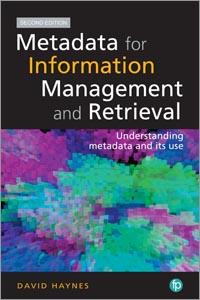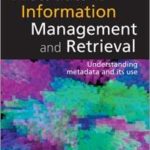Metadata for Information Management and Retrieval: Understanding Metadata and its Uses, 2nd ed.
Source: alastore.ala.org
Authors: David Haynes
Publisher: Facet Publishing
Publication Date: 2018
Length: 288 pages
Price: $69
ISBN: : 978-I-85604-824-8
As part of my activities as a records manager and archivist, I regularly collect and create metadata without articulating my philosophy about doing so or possessing great expertise in either activity. This book encourages reflection on how and why we use metadata. It is aimed at information professionals in museums, libraries, and archives, as well as publishers and managers of institutional repositories and research .
Divided by Concepts, Purposes, Methods
Author David Haynes, a British consultant educator, has revised this edition to provide a “tutorial on metadata” and reveal how it operates, from the perspective of the user and the manager, using examples of document-based content, museum objects, and digital resources. The book is divided into discussions of metadata concepts (definitions), metadata purposes (including Haynes’ revised six-point model), and ways to manage metadata. The last also shoehorns in the politics and ethics of metadata, while covering topics such as linked data, big data, and research data collections.
Complex Structure for Complex Topic
The complexity of the methodologies employed to create, manage, and use metadata is inherent both in the structure of the chapters and in the definitions Haynes uses, in which different but related concepts, such as models and standards, recursively describe each other. Some concepts even play dual or triple roles. This means that while the graphical representations of selected concepts are useful, the book would also benefit from a summary graphic showing these roles and relationships. In addition to defining and describing the concepts in the first section, Haynes also points out which are more successful and how far their use has spread.
Some Topics Need More Coverage
In this edition, Haynes expands his own previous five-point model to six points in order to separate previously amalgamated purposes for metadata and to make a distinction between their purposes and intrinsic properties.
How Metadata Supports IG
One of these purposes is the way metadata supports information governance (IG) efforts, an area increasingly visible and active. This inclusion is important and laudable, but Haynes focuses on granular applications, such as the audit trail and compliance aspects of IG, without expounding on the role of metadata in the larger frameworks that help us understand our organizational or sector-wide information environments in the round. For example, it would be useful for the discussion of intellectual property rights to be tied more closely to IG because metadata can help track the former and therefore support organizational policy via the latter.
Lifecycle, Continuum Comparison
Much of the third section seems light on the ground. The metadata management discussion of the information and “records lifecycle” approach as set out by ISO standard 15489-2016 for records of all formats would benefit from comparison with the records continuum approach. The continuum approach, as explained by Sue McKemmish in her 2002 Archival Science article “Placing records continuum theory and practice,” explicitly relies on metadata to manage the information object over time by a simultaneous multitude of actors or stakeholders.
Contribution of Museums
As someone with a professional background in museum archival work, I was intrigued by its inclusion but disappointed by the small amount of material within that context. The key contribution of the museum appears to revolve around the prominence of provenance and its role in proof of authenticity within the art world (which actually calls it provenience), although Haynes does mention that archival records also rely on provenance. I was hoping for a more robust exploration of cross-walking metadata to manage museum objects, their surrogates, and related archival records within and between collections management databases and other applications, such as digital asset management systems. That discussion is not here.
Crowdsourcing
Similarly, the politics of crowdsourcing is glossed over in a small mention within a subsection entitled “who pays,” and, interestingly, this is not linked to the sections on power (which explore the question of who owns the metadata space) or exploitation. (Haynes appears to use the term “exploitation” in the sense of commercial exploration of metadata.) There is also no discussion of the politics of the commercial algorithms that disempower under-represented communities by weighting search terms in ways that may return archaic, racist, or offensive results; here, he neglects a high-profile topic in public and private libraries, archives, and museums. Haynes confines his explanation of algorithms to the ranking of web pages via metadata.
Two-Thirds Satisfying
The ultimate question is whether this new edition’s “tutorial” is substantial and substantive. The first two sections of the book are both; the third feels less so.
[ls_content_block id=”430″]

